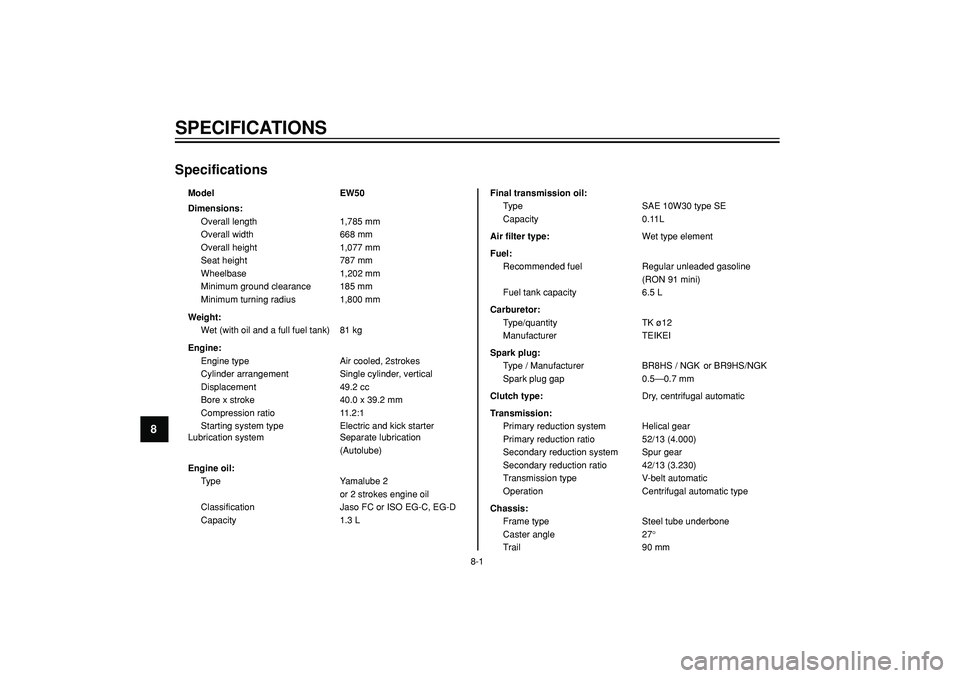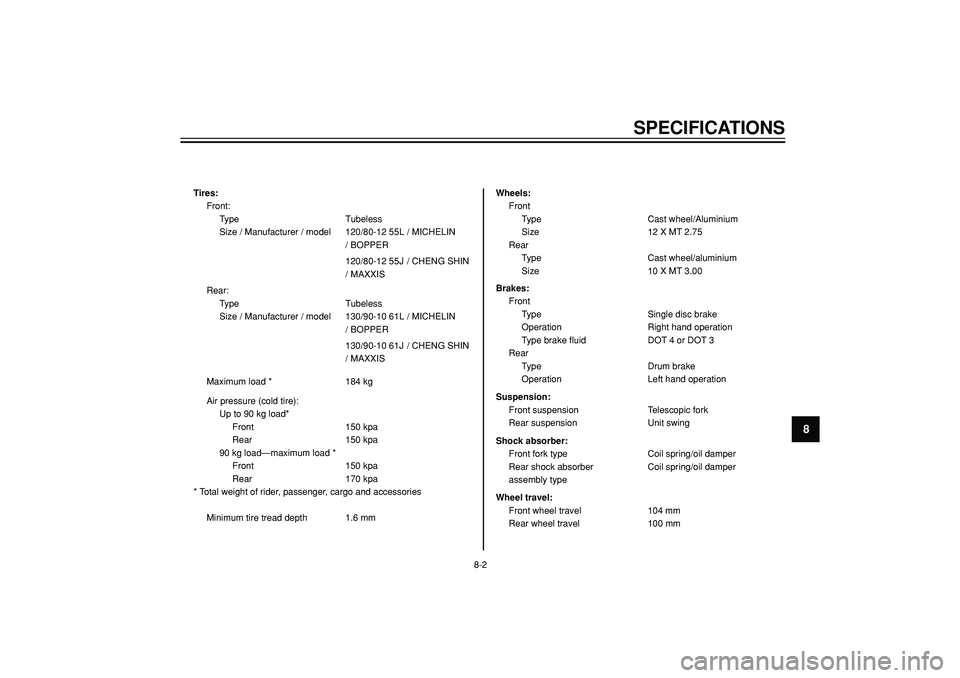YAMAHA SLIDER 50 2005 Repair Manual
Manufacturer: YAMAHA, Model Year: 2005, Model line: SLIDER 50, Model: YAMAHA SLIDER 50 2005Pages: 80, PDF Size: 2.06 MB
Page 61 of 80

EAU03434
SCOOTER CARE AND STORAGE
Care .................................................................................................... 7-1
Storage ............................................................................................... 7-4
7
Page 62 of 80

SCOOTER CARE AND STORAGE
7
CareWhile the open design of a scooter
reveals the attractiveness of the
technology, it also makes it more
vulnerable. Rust and corrosion can
develop even if high-quality
components are used. A rusty exhaust
pipe may go unnoticed on a car,
however, it detracts from the overall
appearance of a scooter. Frequent and
proper care does not only comply with
the terms of the warranty, but it will also
keep your scooter looking good, extend
its life and optimize its performance.Before cleaning
1. Cover the muffler outlet with a
plastic bag after the engine has
cooled down.
2. Make sure that all caps and
covers as well as all electrical
couplers and connectors,
including the spark plug cap, are
tightly installed.
3. Remove extremely stubborn dirt,
like oil burnt onto the crankcase,
with a degreasing agent and a
brush, but never apply such
products onto seals, gaskets and
wheel axles. Always rinse the dirt
and degreaser off with water.Cleaning
ECA00011
•
Avoid using strong acidic wheel
cleaners, especially on spoked
wheels. If such products are used
on hard-to-remove dirt, do not
leave the cleaner on the affected
area any longer than instructed.
Also, thoroughly rinse the area off
with water, immediately dry it, and
then apply a corrosion protection
spray.
•
Improper cleaning can damage
windshields, cowlings, panels
and other plastic parts. Use only
a soft, clean cloth or sponge with
mild detergent and water to clean
plastic.
•
Do not use any harsh chemical
products on plastic parts. Be sure
to avoid using cloths or sponges
which have been in contact with
strong or abrasive cleaning
products, solvent or thinner, fuel
(gasoline), rust removers or
inhibitors, brake fluid, antifreeze
or electrolyte.
7-1
Page 63 of 80

SCOOTER CARE AND STORAGE
7
•
Do not use high-pressure
washers or steam-jet cleaners
since they cause water
seepage and deterioration in
the following areas: seals (of
wheel and swingarm bearings,
fork and brakes), electric
components (couplers,
connectors, instruments,
switches and lights), breather
hoses and vents.
•
For scooters equipped with a
windshield: Do not use strong
cleaners or hard sponges as
they will cause dulling or
scratching. Some cleaning
compounds for plastic may
leave scratches on the
windshield. Test the product on
a small hidden part of the
windshield to make sure that it
does not leave any marks. If the
windshield is scratched, use a
quality plastic polishingcompound after washing.
After normal use
Remove dirt with warm water, a mild
detergent, and a soft, clean sponge,
and then rinse thoroughly with clean
water. Use a toothbrush or bottlebrush
for hard-to-reach areas. Stubborn dirt
and insects will come off more easily if
the area is covered with a wet cloth for
a few minutes before cleaning.After riding in the rain, near the seaor on salt-sprayed roads
Since sea salt or salt sprayed on the
roads during winter are extremely cor-
rosive in combination with water, carry
out the following steps after each ride
in the rain, near the sea or on salt-
sprayed roads.NOTE :
Salt sprayed on roads in the winter mayremain well into spring.1. Clean the scooter with cold water
and a mild detergent after the
engine has cooled down.
ECA00012
Do not use warm water since it
increases the corrosive action of thesalt.
2. Apply a corrosion protection spray
on all metal, including chrome-
and nickel-plated, surfaces to
prevent corrosion.
7-2
Page 64 of 80

SCOOTER CARE AND STORAGE
7After cleaning
1. Dry the scooter with a chamois or
an absorbing cloth.
2. Use a chrome polish to shine
chrome, aluminum and stainless-
steel parts, including the exhaust
system. (Even the thermally
induced discoloring of stainless-
steel exhaust systems can be
removed through polishing.)
3. To prevent corrosion, it is
recommended to apply a corro-
sion protection spray on all metal,
including chrome- and nickel-
plated, surfaces.
4. Use spray oil as a universal
cleaner to remove any remaining
dirt.
5. Touch up minor paint damage
caused by stones, etc.
6. Wax all painted surfaces.
7. Let the scooter dry completely
before storing or covering it.
EWA00002
•
Make sure that there is no oil
or wax on the brakes or tires. If
necessary, clean the brake
discs and brake linings with a
regular brake disc cleaner or
acetone, and wash the tires
with warm water and a mild
detergent.
•
Before operating the scooter
test its braking performanceand cornering behavior.
ECA00013
•
Apply spray oil and wax
sparingly and make sure to
wipe off any excess.
•
Never apply oil or wax to any
rubber and plastic parts, but
treat them with a suitable care
product.
•
Avoid using abrasive polishing
compounds as they will wearaway the paint.
NOTE :
Consult a Yamaha dealer for advice onwhat products to use.
7-3
Page 65 of 80

SCOOTER CARE AND STORAGE
7
StorageShort-term
Always store your scooter in a cool, dry
place and, if necessary, protect it
against dust with a porous cover.
ECA00015
•
Storing the scooter in a poorly
ventilated room or covering it
with a tarp, while it is still wet,
will allow water and humidity to
seep in and cause rust.
•
To prevent corrosion, avoid
damp cellars, stables (because
of the presence of ammonia)
and areas where strongchemicals are stored.Long-term
Before storing your scooter for several
months:
1. Follow all the instructions in the
"Care" section of this chapter.
2. Drain the carburetor float
chamber by loosening the drain
bolt; this will prevent fuel deposits
from building up. Pour the drained
fuel into the fuel tank.
3. Fill up the fuel tank and add fuel
stabilizer (if available) to prevent
the fuel tank from rusting and the
fuel from deteriorating.
4. Perform the following steps to
protect the cylinder, piston rings,
etc. from corrosion.
a. Remove the spark plug cap
and spark plug.
b. Pour a teaspoonful of engine
oil into the spark plug bore.
c. Install the spark plug cap onto
the spark plug, and then place
the spark plug on the cylinder
head so that the electrodes are
grounded. (This will limit
sparking during the next step.)
d. Turn the engine over several
times with the starter. (This will
coat the cylinder wall with oil.)
e. Remove the spark plug cap
from the spark plug, and then
install the spark plug and the
spark plug cap.
EWA00003
To prevent damage or injury from
sparking, make sure to ground the
spark plug electrodes while turningthe engine over.
5. Lubricate all control cables and
the pivoting points of all levers and
pedals as well as of the sidestand/
centerstand.
6. Check and, if necessary, correct
the tire air pressure, and then lift
the scooter so that both of its
wheels are off the ground.
Alternatively, turn the wheels a
little every month in order to
prevent the tires from becoming
degraded in one spot.
7-4
Page 66 of 80

SCOOTER CARE AND STORAGE
77. Cover the muffler outlet with a
plastic bag to prevent moisture
from entering it.
8. Remove the battery and fully
charge it. Store it in a cool, dry
place and charge it once a month.
Do not store the battery in an
excessively cold or warm place
(less than 0 °C or more than 30
°C). For more information on
storing the battery, see page 6-19.
NOTE :
Make any necessary repairs beforestoring the scooter.
7-5
Page 67 of 80

EAU01038
SPECIFICATIONS
Specifications ...................................................................................... 8-1
Conversion table ................................................................................. 8-4
8
Page 68 of 80

SPECIFICATIONS
8
8-1 Model EW50
Dimensions:
Overall length 1,785 mm
Overall width 668 mm
Overall height 1,077 mm
Seat height 787 mm
Wheelbase 1,202 mm
Minimum ground clearance 185 mm
Minimum turning radius 1,800 mm
Weight:
Wet (with oil and a full fuel tank) 81 kg
Engine:
Engine type Air cooled, 2strokes
Cylinder arrangement Single cylinder, vertical
Displacement 49.2 cc
Bore x stroke 40.0 x 39.2 mm
Compression ratio 11.2:1
Starting system type Electric and kick starter
Lubrication system Separate lubrication
(Autolube)
Engine oil:
Type Yamalube 2
or 2 strokes engine oil
Classification Jaso FC or ISO EG-C, EG-D
Capacity 1.3 LFinal transmission oil:
Type SAE 10W30 type SE
Capacity 0.11L
Air filter type:Wet type element
Fuel:
Recommended fuel Regular unleaded gasoline
(RON 91 mini)
Fuel tank capacity 6.5 L
Carburetor:
Type/quantity TK ø12
Manufacturer TEIKEI
Spark plug:
Type / Manufacturer BR8HS / NGK or BR9HS/NGK
Spark plug gap 0.5—0.7 mm
Clutch type:Dry, centrifugal automatic
Transmission:
Primary reduction system Helical gear
Primary reduction ratio 52/13 (4.000)
Secondary reduction system Spur gear
Secondary reduction ratio 42/13 (3.230)
Transmission type V-belt automatic
Operation Centrifugal automatic type
Chassis:
Frame type Steel tube underbone
Caster angle 27°
Trail 90 mm
Specifications
Page 69 of 80

SPECIFICATIONS
8
8-2 Tires:
Front:
Type Tubeless
Size / Manufacturer / model 120/80-12 55L / MICHELIN
/ BOPPER
120/80-12 55J / CHENG SHIN
/ MAXXIS
Rear:
Type Tubeless
Size / Manufacturer / model 130/90-10 61L / MICHELIN
/ BOPPER
130/90-10 61J / CHENG SHIN
/ MAXXIS
Maximum load * 184 kg
Air pressure (cold tire):
Up to 90 kg load*
Front 150 kpa
Rear 150 kpa
90 kg load—maximum load *
Front 150 kpa
Rear 170 kpa
* Total weight of rider, passenger, cargo and accessories
Minimum tire tread depth 1.6 mmWheels:
Front
Type Cast wheel/Aluminium
Size 12 X MT 2.75
Rear
Type Cast wheel/aluminium
Size 10 X MT 3.00
Brakes:
Front
Type Single disc brake
Operation Right hand operation
Type brake fluid DOT 4 or DOT 3
Rear
Type Drum brake
Operation Left hand operation
Suspension:
Front suspension Telescopic fork
Rear suspension Unit swing
Shock absorber:
Front fork type Coil spring/oil damper
Rear shock absorber Coil spring/oil damper
assembly type
Wheel travel:
Front wheel travel 104 mm
Rear wheel travel 100 mm
Page 70 of 80

SPECIFICATIONS
8
8-3 Electrical:
Ignition system type C.D.I
Charging system Flywheel magneto
BatteryModel GM4-3B, YB4L-B, FB4-B
Voltage/capacity 12 V / 4 Ah
Headlight type:Bulb
Bulbs (voltage/wattage x quantity):
Headlight 12V, 35W/35Wx1
Tail/brake light 12V, 5W/21Wx1
Turn signal light
Front 12V, 10Wx2
Rear 12V, 10Wx2
Meter lights 12V, 1.2Wx2
High beam indicator light 12V, 2Wx1
Turn signal indicator light 12V, 2Wx1
Oil level warning light 12V, 2Wx1
Fuel level warning light 12V, 2Wx1
Fuses:
Main fuse 7A